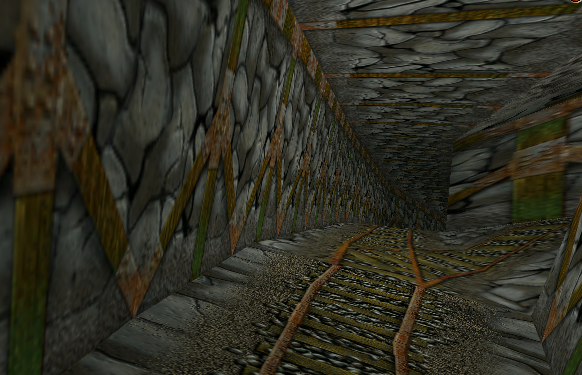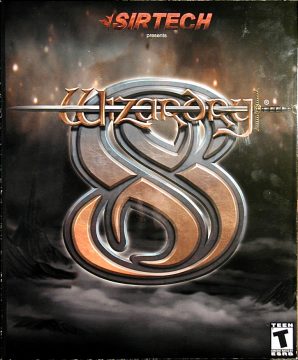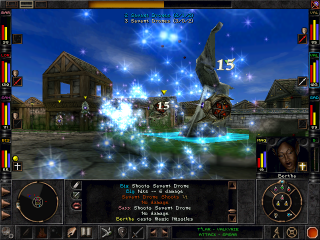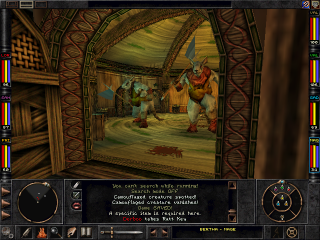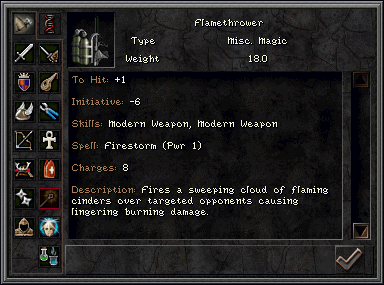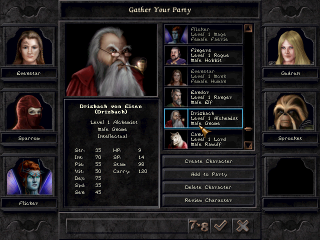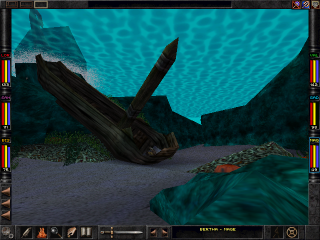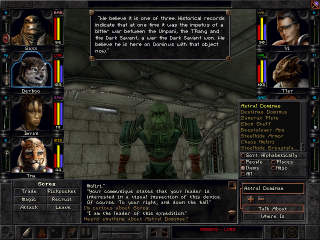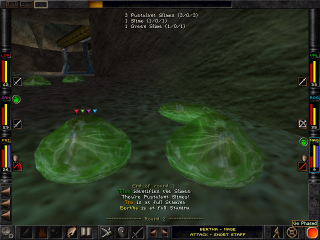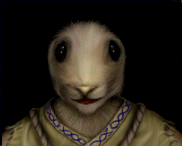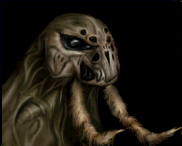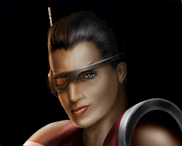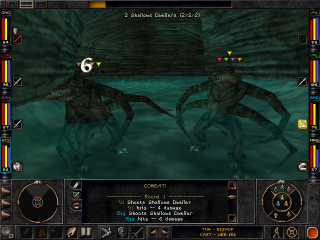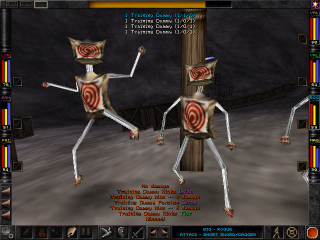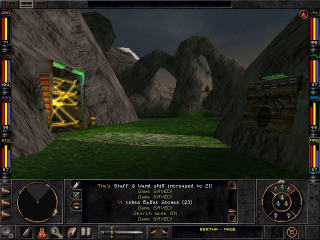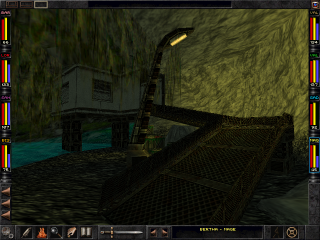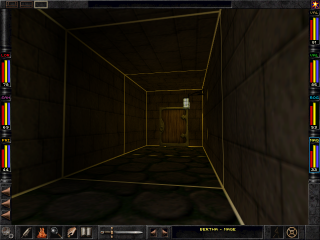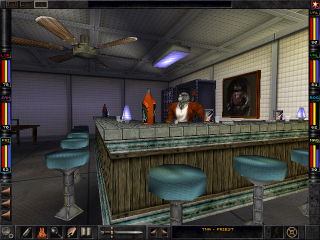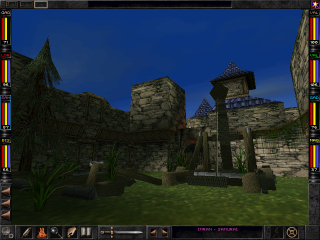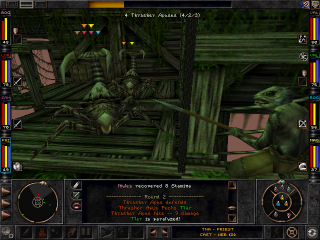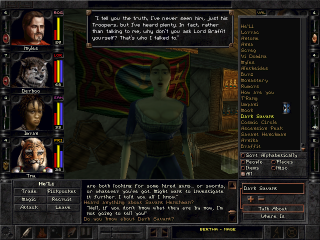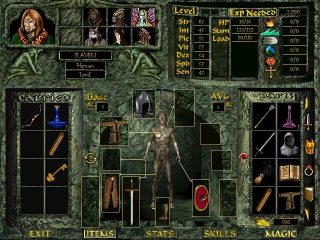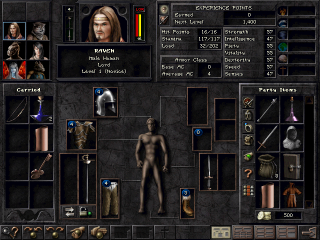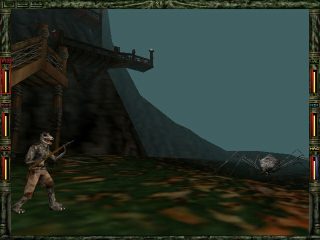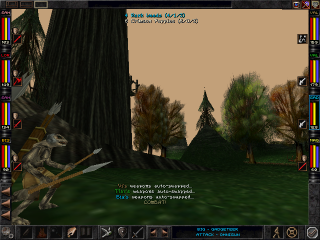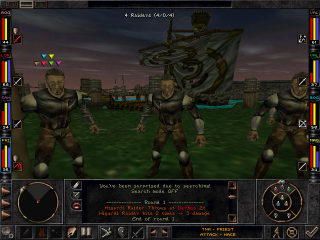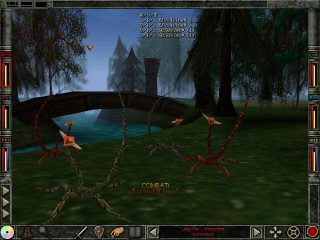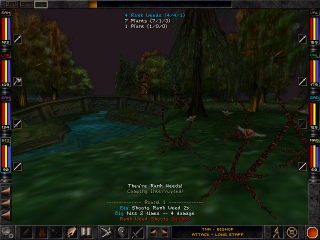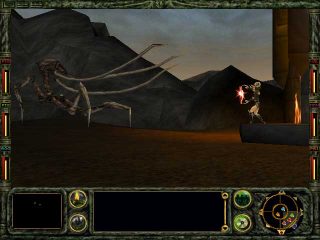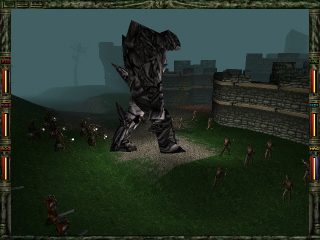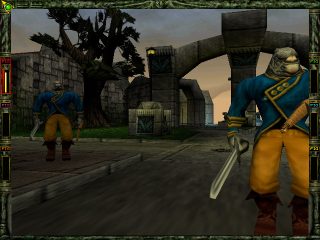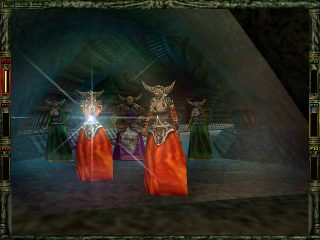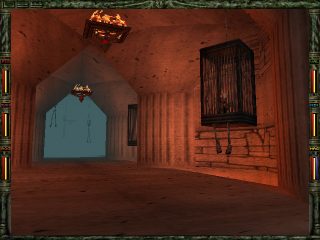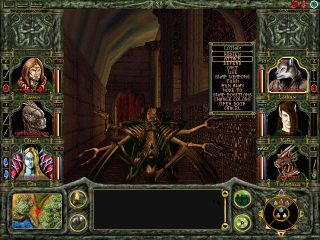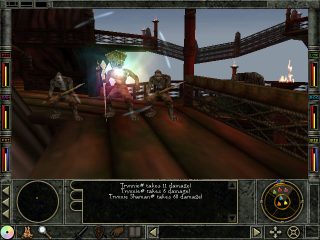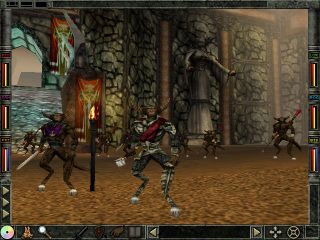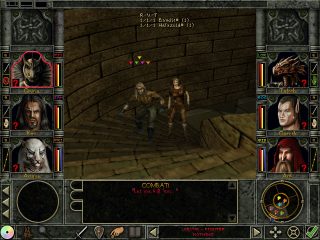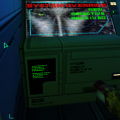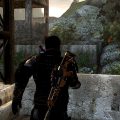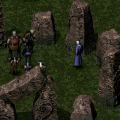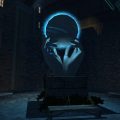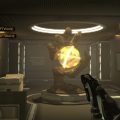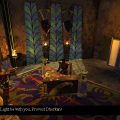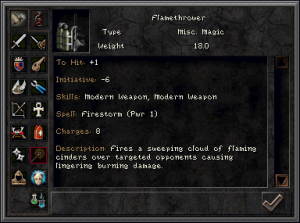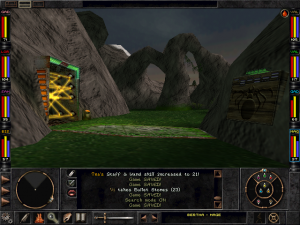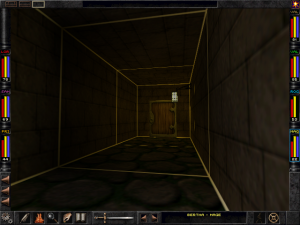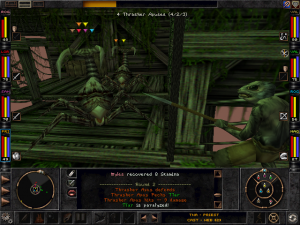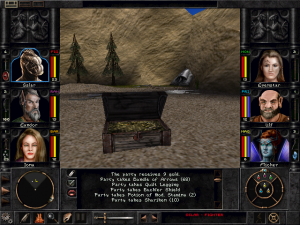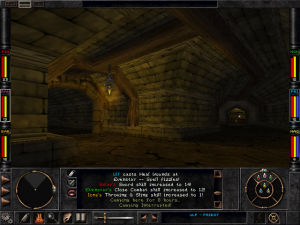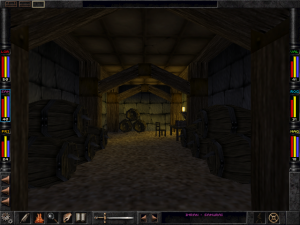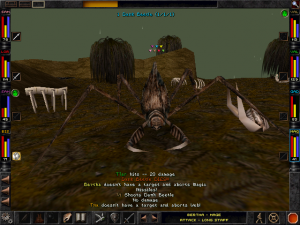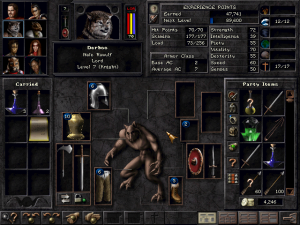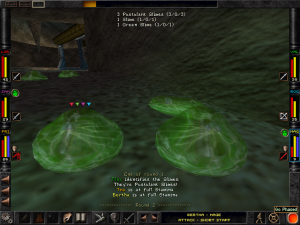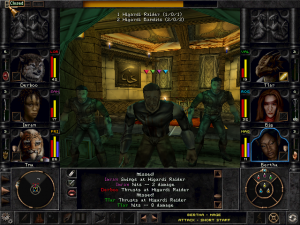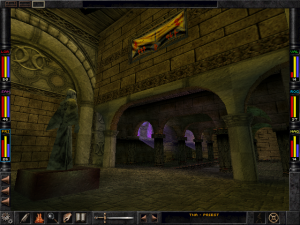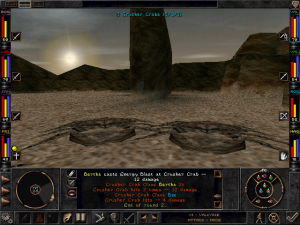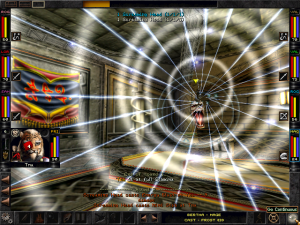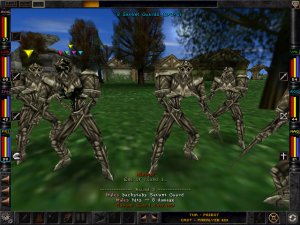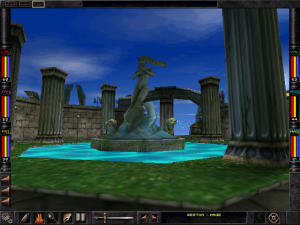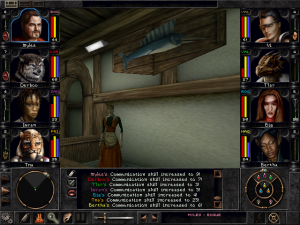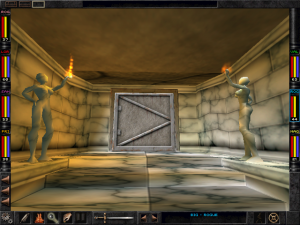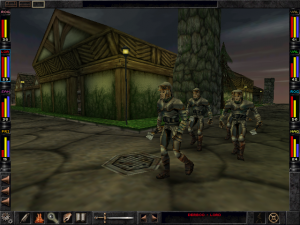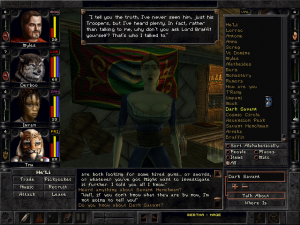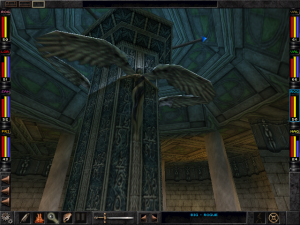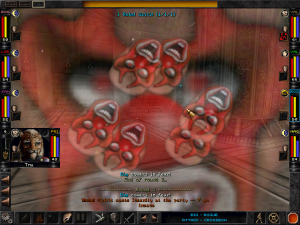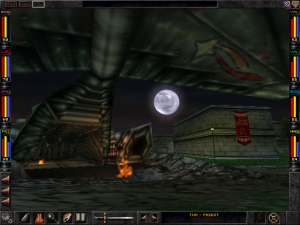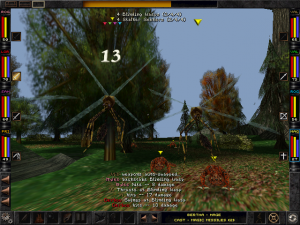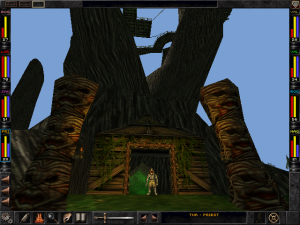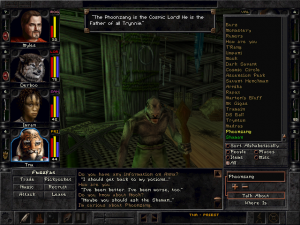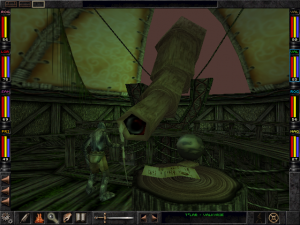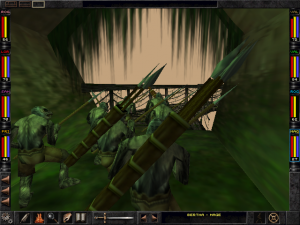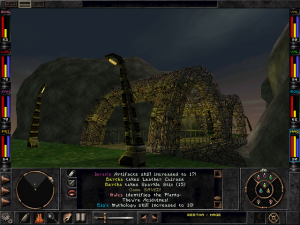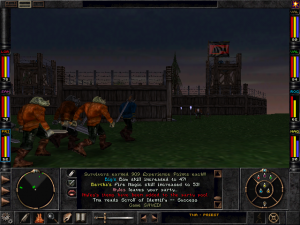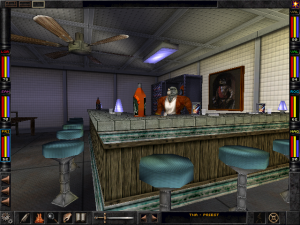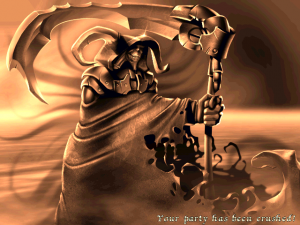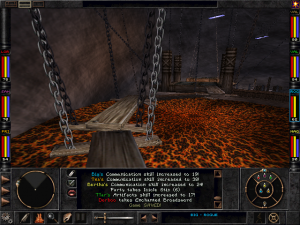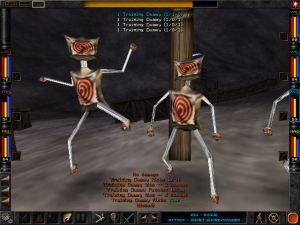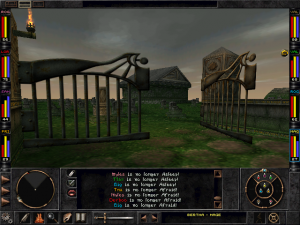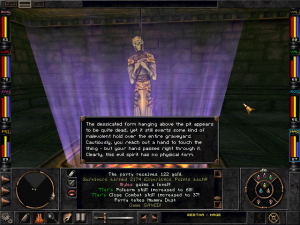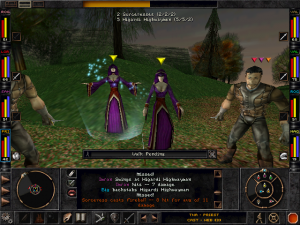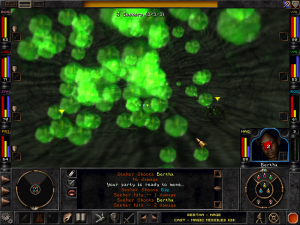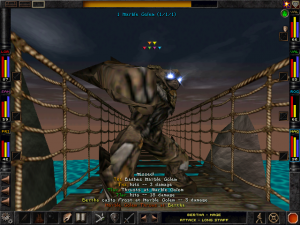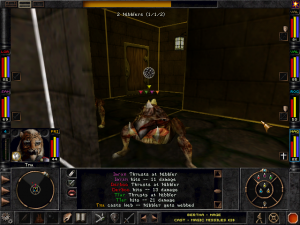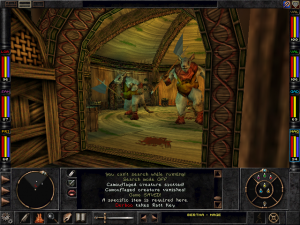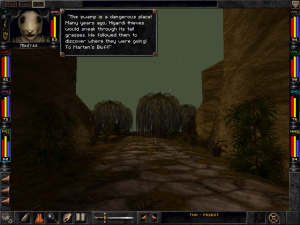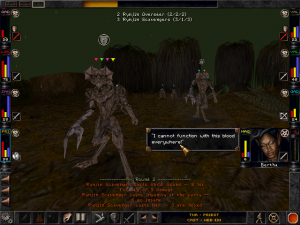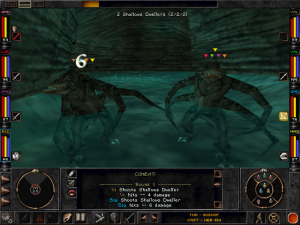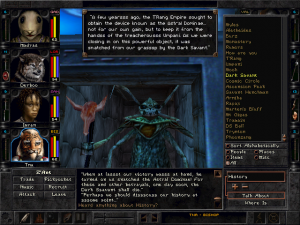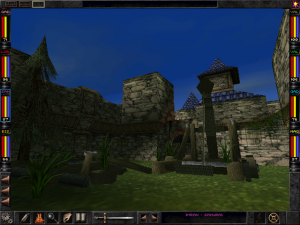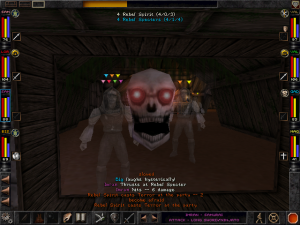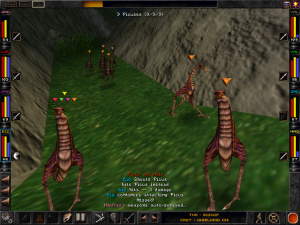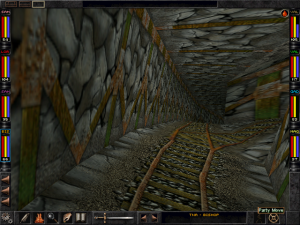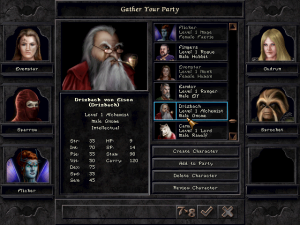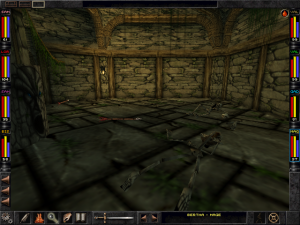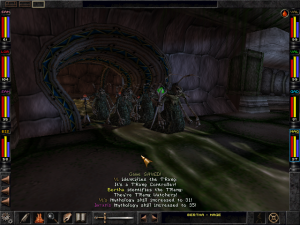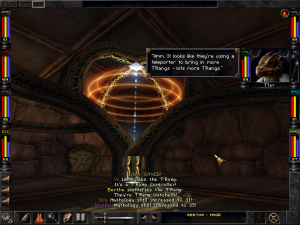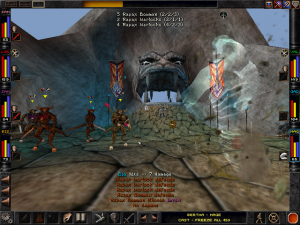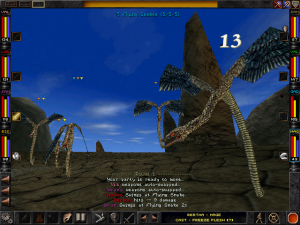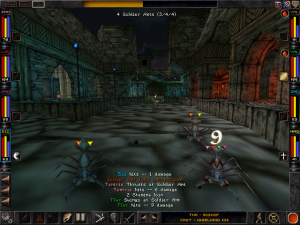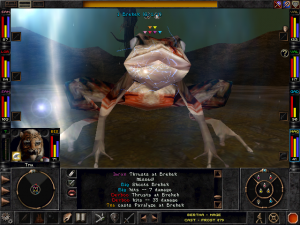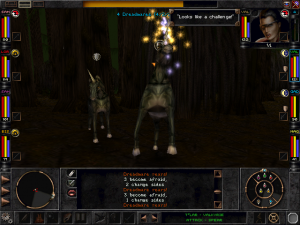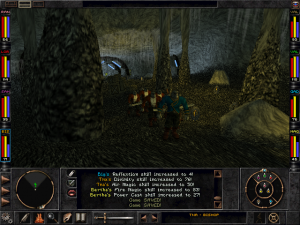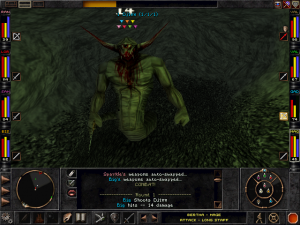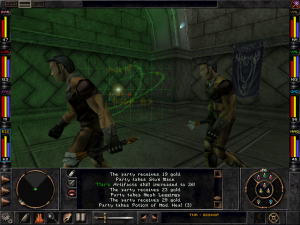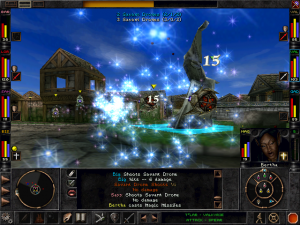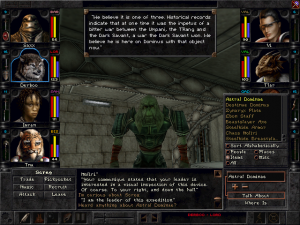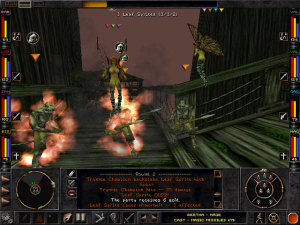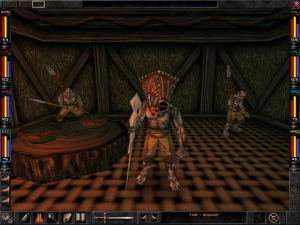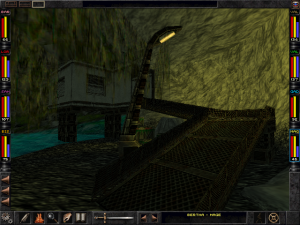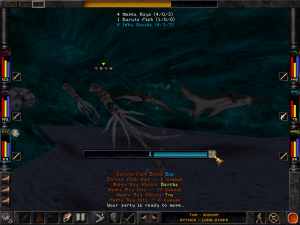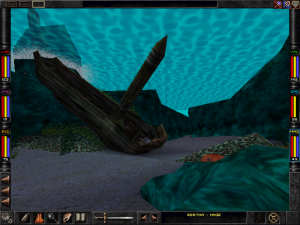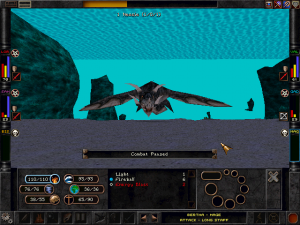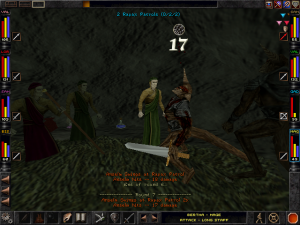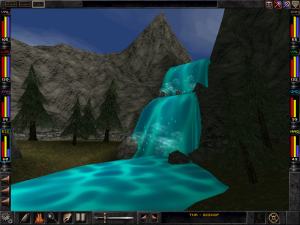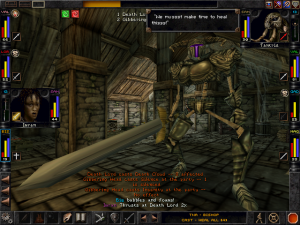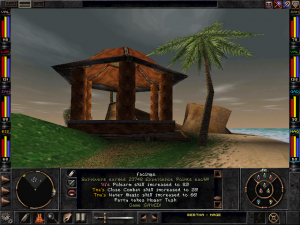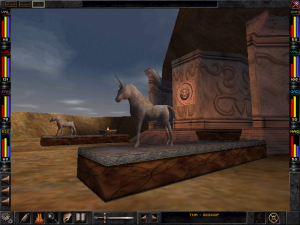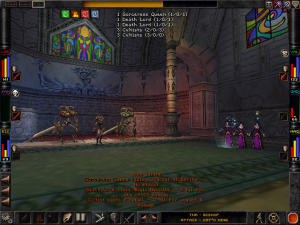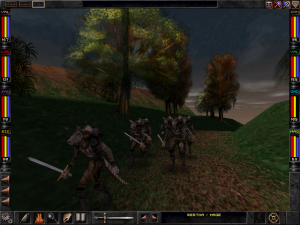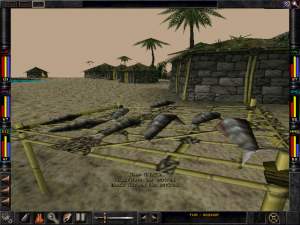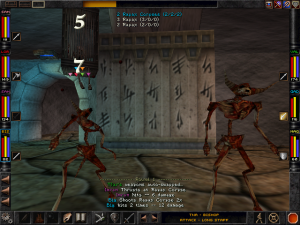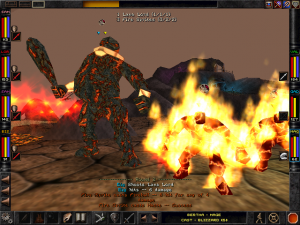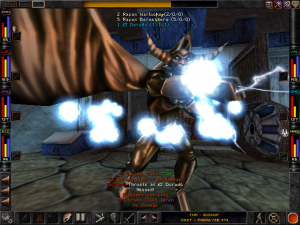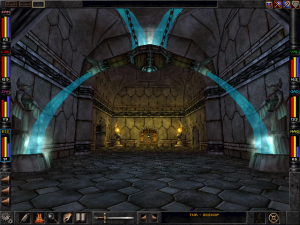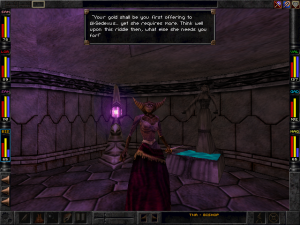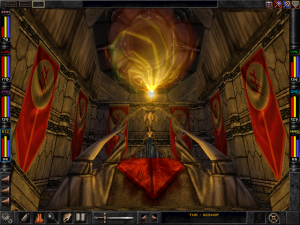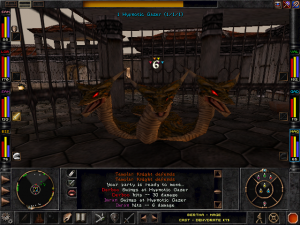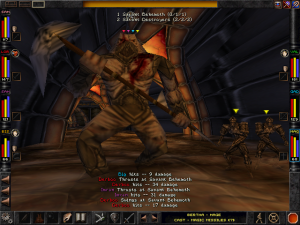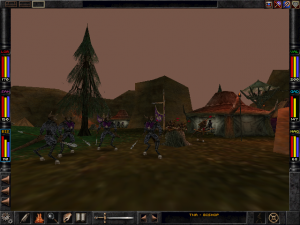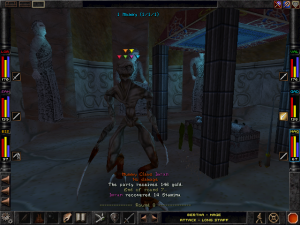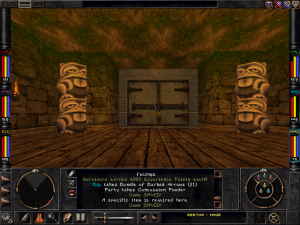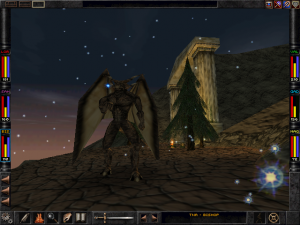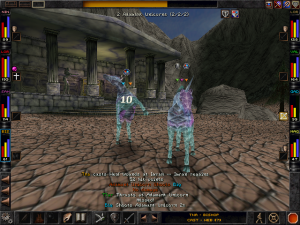- Wizardry (Series Introduction)
- Wizardry: Proving Grounds of the Mad Overlord
- Wizardry: Knight of Diamonds
- Wizardry: Legacy of Llylgamyn
- Wizardry: Llylgamyn Trilogy Version Comparison
- Wizardry: The Return of Werdna
- Wizardry V: Heart of the Maelstrom
- Wizardry: Bane of the Cosmic Forge
- Wizardry: Crusaders of the Dark Savant
- Nemesis: The Wizardry Adventure
- Wizardry: Stones of Arnhem
- Wizardry 8
- Wizardry: Japanese Franchise Outlook
- Wizards & Warriors (2000)
- Wizardry Online
- Robert Woodhead (Interview)
- Wizardry Mobile Games & Other Media
Just as quickly as classic CRPGs had “died”, they rose again after Diablo, Fallout and Ultima Online had demonstrated that the label didn’t have to be diminishing to sales. Might and Magic returned with a sixth iteration in 1998, followed by Ultima IX: Ascension a year after. Sirtech, too, resolved to bring their flagship series back. The company first announced Wizardry 8 on its homepage in June 1997, and by early projections the game was supposed to come out in fall 1998. It didn’t quite work out that way. Sirtech in the US went bancrupt in the middle of development, but since the game was being made at the Canadian subsidiary, development trickled on. With the mother company out of business, however, Sirtech Canada had a hard time finding a publisher, and the game ended up being distributed in North America exclusively by Electronics Boutique on November 15, 2001.
Wizardry VII ended on a rather nasty cliffhanger – the Dark Savant had conquered the Astral Dominae and escaped from Guardia. Even after all those years, Wizardry 8 fortunately picks up the storyline to conclude it. Now the villain is headed for the world of Dominus to find the next of the Cosmic Lords’ artifacts, the Destinae Dominus. On the other end of the galaxy, the Mook (which were hinted at having alien origins in the previous games, even though it’s never explained why they would know nothing about belonging to a spacefaring explorer race) find the third and final artifact, the Chaos Moliri, which also leads them to Dominus – conveniently allowing the arc about the Cosmic Lord artifacts to get wrapped up in one more game.
Perhaps even more astonishingly, Wizardry 8 still accepts completed games from the almost ten years older Crusaders of the Dark Savant to be imported. Veteran parties arrive on Dominus in company of the faction they sided with in the previous game – both the T’rang and Umpani return with bases on the new planet, whereas new players are led there by Grimpak the Mook. Either way, all incoming ships are shot down by the Dark Savant and forced to crashland, leaving the party alone to find their way around on its own. Dominus is home to another low tech civilization, which deviates yet further from the standard fantasy tropes – there’s the typical medieval European type settlement home to the human Higardi, (even though they are clearly a spacefaring civilization), but they’re neighbors to the Trynnie tribe of humanoid rodents, who live in an Ewok-style treehouse village, and the horned Rapax, who worship an evil demon goddess.
For those who start a new party with this game, the character creation process is much less frustrating than it used to be, throwing out the outdated random dice roll system. Instead, every character gets a fixed pool of bonus points, which is adjusted according to the race and class selections. Every class is available to every character from the beginning, but a Fairy wizard will have much more attribute points left available for free distribution than a dwarven ninja. The point distribution upon level-up has been equally streamlined – every character is always given six points to distribute to the main attributes and nine points for skills, but each individual value can only raised by three each time. The latter are reverted back to the system from Bane of the Cosmic Forge, so there’s only one shared pool for all skills. The seven base attributes – karma and personality have been retired and replaced by a new “senses” stat, which influences the initiative in combat and the ability to find hidden items – have been converted to a base of 100 just like skills, and maxing out any of them provides a character with a special skill that cannot be attained any other way, and some of them are quite powerful, so it pays to specialize characters early.
The races and classes remain the same as the predecessors, but a single new job is introduced with the gadgeteer, who is proficient in firearms (which were only available as a special personal skill in Wizardry VII) and can build gadgets from seemingly useless junk. A gadgeteers tools range from silly contraptions like a Jack in the Box to startle enemies to high tech gear like a forcefield generator (built from an inductor and a magnet, no less) or a holograph projector, and they work in a similar fashion as a bard’s instruments in that they’re essentially unlimited uses for certain spells. The firearms include devastating weapons like a flamethrower or a grenade launcher. Each gadgeteer also carries a personal omnigun, which gets leveled up together with its owner. In the beginning it can merely shoot stones and bullets, but with subsequent upgrades it becomes capable of firing almost any kind of projectile available in the game.
The biggest changes among the established classes come for the magic users – in addition to the different schools of spells, skill points have to be invested for every single one of the six “elements” as well, so mages, priests or bishops hardly have ever any points left for any other skill. Heroes are now much more likely to gain additional skill points through usage, though, so it’s even feasible (though tedious) to just stand around and practice spells in a safe spot where the party can rest at any time. Casting magic also works a bit differently: The power of a spell can be chosen freely as long as the caster has enough spell points ready, but the higher it goes above the according elemental skill, the harder it becomes, signified by color coding from green to yellow, orange and red. Attempting to cast beyond the character’s abilities produces higher risks for the spell to fizzle, or even backfire on the party.
The thieving abilities also underwent some changes, though not necessarily for the better. Disarming traps works roughly the same way as in Wizardry VII, only now every action is buffered with waiting for a progress bar to fill up, which does nothing but waste your time. It’s also quite unlikely for a trained thief to be wrong at identifying a trap, so unless the party is short of a proper professional, there’s little point at all to the mini game. Unlocking doors seems interesting at first: Each lock consists of two to eight bolts, which are raised simply by clicking on them. However, when a bolt is raised it has a chance of making any number of other bolts drop, depending on the character’s skill level. That means there is a statistical chance of cracking most locks even with insufficient skills, but with five or more bolts, this gets annoying quickly. Very well implemented is the way magic supports the process, though: A knock knock spell keeps a few of the bolts up no matter what, making the thief’s job significantly easier. With more than one mage in the party, it’s also possible to combine their spells.
Changing a character’s class in the middle of the adventure is still possible, but unfortunately the rules for that have been modified in a way that makes it almost without exception a bad idea. Unlike previous games, a character’s level is not reset upon class change, so there is no advantage of added level-ups. All a class change does is lock characters out of previously trained skills that don’t belong to the new class, and put them at a disadvantage in learning the new skills. The only even remotely reasonable transitions are the few that don’t come with any skill discrepancies and predominantly rely on the same abilities, like from a fighter to a lord or valkyrie, but even then there’s no reason to not start with the desired final class to begin with.
The game world ist structured very similarly to Crusaders of the Dark Savant, but the fact that it builds a fully realized, freely explorable world – where not almost every place looks the same – goes a long way to make things more player friendly and much easier to manage. There’s an handy automap that allows sticking comments to noteworthy locations (but loading it up always takes a second or so) and a journal that automatically keeps important notes. It has a rather simple functionality, but it groups notes by location and marks uncompleted quests in a different color, and that is really all that’s necessary to keep track of tasks. The world is not as enormous as a Morrowing or even a Might and Magic VI with its hundreds of subquests and promotions and months of grinding and like Wizardry VII mostly a set of confined locations connected by a set of paths, but it is huge compared to any previous Wizardry game. Unfortunately much of the size comes about through very spacious outdoor areas, which take a lot of time to traverse. Running speeds things up, but consumes stamina, which can turn into a problem when the party happens upon strong enemies during a sprint. Later in the game a few teleport options become available, but they remain very limited, and players need to be prepared to waste a lot of time backtracking.
Interactions with non-player characters go down more or less the same way as they did ever since Wizardry V – the changes are mostly a matter of comfort. The game now keeps a list of keywords for every person, place, artifact or otherwise notable topic, which can be filtered by exactly those categories. It’s also possible to instruct the program to only register the most essential keywords and fill in the rest manually, although that only sets you up for frustration, as the parser still isn’t very powerful, as evidenced in the few cases where the game expects players to guess the keywoards on their own. When a certain character mentions his theory about the true purpose of an object, for example, the conversation can only be driven forward with “theory”, but not with “purpose” or “true purpose”. The name of the object itself likewise only triggers a repetition of the previous line.
As many of the screenshots show, it’s often possible to run around Dominus with a party of eight characters, although only six are created/imported at the beginning of the game. The other two slots are reserved to invite a range of NPCs – the game calls them RPCs, for “recruitable player characters – to tag along. This seems suspiciously similar to Might and Magic VI, but different to New World Computing’s RPG comeback, these characters are mostly treated like full-fledged party members, with manageable inventories, full control over combat actions and even level ups. The ten available companions are a varied mixture of almost all races and classes, and include some really interesting types beyond the usual stereotypes. One representative of the militaristic Umpani is an old, world-weary jazz bard named Saxx who speaks in a film noir narrator voice. There is also a young Trynnie Ranger who joined the Umpani army and speaks with a terribly annoying cutesy voice, a defective robot of the Dark Savant who can be modified and misapropriated by the party, and even a few friendly T’rang warrios. Vi Domina from the previous game can also join the party early on, and her starting class is a valkyrie. There is also a reunion with Bela, the dragon from Wizardry VI, although he doesn’t join the heroes on their travels.
Whenever RPCs enter one of the major locations for the first time, they have some comment on the surroundings, which makes them feel more like characters that actually inhabit the world rather than just a bunch of added parameters to the combat. Most also have locations they simply will not enter (and become quite distressed if tricked into via teleport), which is unfortunate, as they dump all their equipment on the party when they leave. This may sound like a good thing at first, but the added weight can easily bring their combat abilities down. Disposing of the stuff also isn’t a good idea, as equipment is so specific to classes and sometimes even races – T’rang with their slug bodies cannot wear normal pants, but shoes do fit them, mysteriously – that it’s hard to get a decent set together should the group hire the same character again. There is also no level scaling for inactive RPCs, so they quickly fall behind after prolonged abscensce from the group.
Enemy encounters for once work very different from the rest of the series. Foes now roam the land, and combat is only triggered when they become aware of the group. Without the relevant psyonic spells, however, stealth is almost impossible, and unless the map is designed very favorably for the player, confrontation is usually hard to avoid. Monsters act as individuals, although they’re still divided into groups, which some spells react to. Since they’re all realized objects in the 3D world, they can move around the party, and will usually try to surround them. It is possible to modify their formation on a grid, but the heroes are always stuck together in one space. It seems a bit unfair at first, but there are many opportunities to use walls and other obstacles to the group’s advantage. Ironically this makes open fields much more dangerous than dungeons, because underground enemies can often be railroaded through doorways and other narrows, whereas outside there’s little to hinder them to attack the weak characters in the back.
The actual combat commands, although selected from a graphical popup menu, work similar to earlier games, although there are now two modes to manage time succession. In addition to the regular turn-based method, where everything stops for the player to register commands at leisure, there is also a continuous mode, which keeps running on between rounds and allows the changing of commands at any time. The two modes can be toggled freely, although the button to switch on continuous mode is the same as starting a round in turn-based mode, so it’s easy to flip the switch accidentally. The party can also choose to walk or run in the middle of combat to either run away or approach enemies that attack from range, but regardles off the mode of progression, the movement phase is only triggered at the end of a new round before any of the characters have executed their actions.
Since all characters outside of the party have to act out their animations in the 3D world, combat unfortunately can turn into a slog when there is a lot of enemies walking around, or projectiles are shot over a very long range. There is an option to control the animation speed, but everything but the highest setting is simply intolerable. If there are any friendly NPCs around when combat starts, they go and help the player. This can be quite useful when the characters still are comparatively weak, especially since they’re still awarded the full experience points (but on average less skill points). On the other hand, their interference tends to slow down combat even more, and it’s possible for unique NPCs to get killed in combat (although the really important ones are usually positioned in safe locations).
As usual, it’s mostly a matter of trial and error to find out which areas the adventurers can take on at any given point in their development, but at least characters with a decent mythology skill can identify enemies from afar, which provides them with detailed status information and an evaluation of their relative strength compared to the party. There is some kind of level scaling in place, which causes higher level enemies to get spawned against a strong group, but there are still plenty of meaninglessly easy encounters. On the other hand, it’s also possible to run into ridiculously tough fights even when revisiting past areas. Characters get killed off easily, and until clerics learn the high level resurrection spell, means to bring the dead back to life are very limited, so save scumming is recommended and almost necessary. Technically, it’s also possible to simply replace fallen heroes with new ones, but that’s really a valid option for those experts who scoff at such weakness and go for the Iron Man mode, which only allows to make temporary save states when quitting the game (and immediately deletes them upon loading – sucks when the game or computer happens to crash), and where every damage is permanent.
After a very involved introductory dungeon, the game scales back a bit on the dungeons, and there are few truly brain-teasing mazes around. On the other hand, even many of the towns partly feel like dungeons, as the party can get attacked almost everywhere and getting around ist just as complicated. There are also a decent number of puzzles that require special items to be used at the right location. Some are from pretty far off like in Wizardry VII, but the game is a bit better at giving hints.
While orientation has gotten easier, puzzles are still obfuscated by the sheer amount of junk the world is filled with. At least the party will refuse to throw away unique quest items, and for the first time in Wizardry history, the inventory is not limited by space, so packrats can rejoice and grab everything they find. All that carried weight still encumbers the characters, though, and each adventurer has only the usual eight slots available to access directly – grabbing stuff from the party inventory costs an extra round in combat. The gathered items also easily go into triple digit territory, so it becomes a real chore to manage things within the limited screen space, despite a number of filter and sorting options. Especially quest items that are needed much later than they are found can easily get buried deep within. Even though it is far from an ideal solution, it’s still the better alternative to being forced to throw away most of the findings like in the previous games. On the downside, some hot spots are really hard to find within the 3D environment.
In case all that is not enough, there are also three easter egg “retro” dungeons which are rather difficult to find. They require touching a number of runes hidden on certain maps, which makes a random object in the vicinity interactive. That still doesn’t unlock the dungeon, cause a more or less arbitrary item is required as a key (the most obvious is sticking an ordinary short sword in a rock within a stonehenge-like structure – but any other type of sword won’t work). Onlt then the party can step into a circle of mushrooms and enter the virtual catacomb. In there, gameplay still works the same as elsewhere, but the structure is very much inspired by the older grid-style dungeons, full of warp plates and invisible traps. They even wrap around at the end, just like in the old days. They also contain some rather tough battles, so they’re not place for a group of rookies. Unfortunately, the look doesn’t quite capture the spirit of the game’s ancestors – there are grid lines along the corridors, but underneath the walls are still fully textured, and the classic games didn’t have segmenting lines on the floor and ceiling tiles, either. In structure, though, these dungeons are still a neat throwback to the past.
A big part of the appeal for Wizardry 8 was to see the Wizardry formula in a fully realized 3D environment. Even though the world is relatively compact, there is a wide range of areas to visit. The party can discover an Egyptian-style tomb within an oriental temple, march through a murky swamp where it always rains, visit the Rapax in their castle on an active volcano. There’s even an underwater area to explore, possibly inspired by the Sir-Tech published Shadows over Riva, only here the heroes aren’t enabled to dive by magic, but modern scuba gear. The sci-fi elements in general are much more pronounced than they used to be. Where the environments in Crusaders of the Dark Savant always had the look of a medieval fantasy world, with descriptions of high technology almost exclusively limited to the text, Dominus is full of space ports, computer terminals and futuristic underground lairs.
The graphics are rather blocky, and while the terrain and buildings are still modeled with a reasonable amount of detail, interiors are often a bit on the sparse side, and trees are just two-part cardboard displays. The viewing range is also rather limited, and when moving new terrain can be plainly seen phased in at the “horizon”. (It’s possible to increase the range in an editor, but it’s a tiresome process as the parameter is stored for each area individually.) It still all manages to look rather good thanks to a competent art direction, but in places Wizardry 8still looks more like an 1998 game than a 2001 game. Visually, it’s about on par with the two years older Ultima IX, and less than a year after its release it was seriously outdated by The Elder Scrolls: Morrowind. As a result of the long development time, different parts of the game do have a bit of an incoherent look – many areas have been completely remodeled since the first previews, but others were simply retouched. The harbour in the human town Arnika, for example, looks mostly the same as it did in 1998, only the sailing ship that stood proudly anchored at the pier now lies sunken to the shallow ground, with its tattered sails protruding to the surface.
Despite a low polygon count, character models are overall of decent quality and well animated. When enemies get damaged, they’re covered in cuts and bruises, providing a rough estimate about how much they have left in them even without checking their data sheet. There is a number of boss enemies, but most are just stronger and/or seriously upscaled versions of regular enemies. Notable exceptions are the topless evil godess Al-Sedaxus, Nessy(!) and the Dark Savant himself.
Most towns and settlements feel eerily abandoned, and aside from the militias that patrol them day and night, there is only ever a handful of NPCs to talk to. Granted, this is explained away by most of them being military bases, others abandoned after most of the population fled from the Dark Savant menace, but either way Dominus doesn’t feel like a sprawling lively world, but like a dying one. Guards also have a nasty habbit of blocking the passageways they’re walking through, and in some places they can even get stuck. This can usually be solved by making the party rest for a while, but when non-moving NPCs take part in a fight and end up standing in the middle of a doorway afterwards, they force the party to return to a previously set magic portal – or lacking that, leaving killing them and making their entire faction hostile in the process as the only way out.
It’s still possible to play Wizardry 8 with the typical interface of the previous two games, with the heroes’ character portraits displayed at all times on either side. Combined with the free 3D movement, however, this look feels seriously claustrophobic, and thankfully it’s possible to have them all reduced to a slim set of status bars for a wider viewing angle. The individual portraits then pop up whenever they have something to say, perform an action or are hit in combat. Below the portraits is a radar (which unfortunately doesn’t do double duty as a mini map, contrary to what early mockup screenshots suggested), a window for status updates and a display of the party’s current formation, all of which can be switched on and off separately. There are some finicky quirks with the controls – a klick with the right mouse button switches between mouselook and cursor controls, but clicking right above an NPC, monster or item opens its status information window instead. Grabbing an item and klicking with the left button on a character puts it in the personal inventory, while klicking right sends it to the party stash – except in combat, where all items go to the shared inventory. After a bit of getting used to, it’s all quite easy to handle, though.
The selection of available character portraits is still rather limited – humans have a wide range of portraits that correspond to different classes available, but for all the other races, there are only two portraits per gender. Any portrait can be assigned to any character, and it shouldn’t be too immersion-breaking to pass a gnome for a dwarf, but not even all the portraits of Wizardry VII are represented with adequate updated versions. In place of the nebulous random karma value, characters’ personalities is chosen from a range of presets, which not only determines their voice, but also changes comments and reaction to certain events in the game. It’s rare that they have anything meaningful to say, though, and it’s not enough to build them up as fleshed-out narrative characters. Many of the voices are also cartoonish extremes, with some horrible fake accents among them. All NPC text is also fully voiced, and it’s about on par with a SatAM cartoon production. This is especially evident whenever the Dark Savant is on screen and acts and talks like a buffoon all the time, after all that work of building him up as a terrible threat to Dominus and the entire universe.
The soundtrack by Kevin Manthei (whom Sir-Tech also employed for Jagged Alliance 2) is more on the athmospheric than the catchy side, but it is very good at capturing the mood of each faction in the world. The music turns martialistic for the Umpani, mysterious for the Trynnie, unsettling for the T’rang, foreboding for the Rapax and homely in Higardi. There are no less than six combat tunes, which all have a somewhat similar sound but are encoded to the severity of encounters. For some reason, there are also two different camping jingles, even though each of them is only 14 seconds long.
Wizardry 8 may have its fair share of hiccups, but overall it offers an intriguing world, an interesting if sparsely narrated quest, and lots of character building and loot amassing appeal. It can’t quite shake that feeling of not being quite complete and polished, but to be fair, not many open world type CRPGs do. Very grating is an entire quest line that’s left dangling incompleted – the adventurers can meet the Rapax queen, who has been locked up by the king for opposing his plans. Talking to her enters an open entry in the quest log, and there are mentions of freeing her, the king’s assassins and other hints at a larger involvement in the power struggle among the Rapax royals, but there doesn’t seem to be any means to advance that thread from there. There are also some game breaking bugs. At one point, for example, it’s necessary to examine skeletons on the floor, which opens an item distribution window but also spawns a ghost each time. If all items aren’t taken the first time, the skeleton cannot be interacted with ever again. The problem is that one of the items is absolutely necessary to complete the game. On the funny side, the good endings have the heroes slowly and solemnly ascending into space from the Cosmic Circle while the epilogue narration plays, but it may occur that they plummet back down to the ground just immediately before the game cuts to the credits.
The return of the big three venerable American CRPG series led to mixed results – Might and Magic VI was ugly and clunky, but offered a solid RPG experience and was successful enough to bring the series back to an almost yearly release schedule for a while, whereas Ultima IX was a disaster on almost every level (but the heart of the franchise was to be found within Ultima Online by that time, anyway). As a late arrival, Wizardry 8 lies somewhere in the middle. It didn’t enable Sirtech to keep producing more sequels – the development team, which had already started concept work on Wizardry 9, was laid off in July 2001, even before Wizardry 8 hit store shelves after long and troubled publisher negotiations. Sirtech Canada continued with skeleton support staff for a while, but never recovered. Nonetheless, even as their last game was moving yet a bit farther away from pure dungeon crawling than Crusaders of the Dark Savant already had, it was still a faithful yet progressive revival and modernization of the series and proved a worthy swansong to at least the North American Wizardry saga.
Comparison Screenshots
Early Preview
Later Preview
